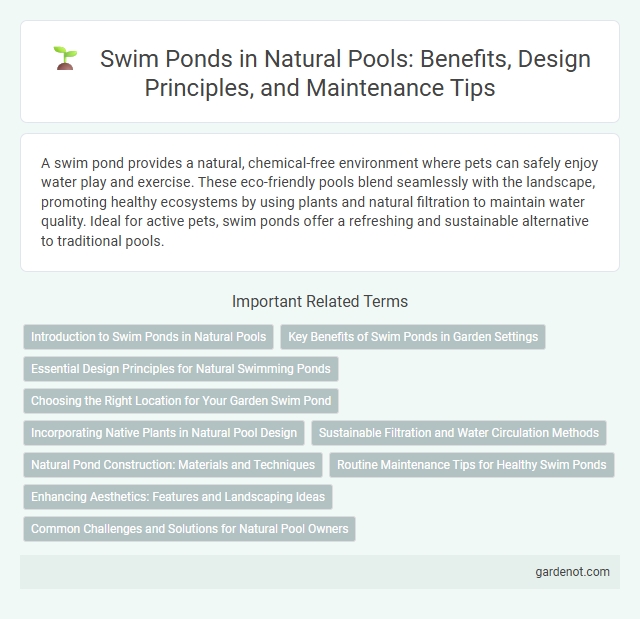A swim pond provides a natural, chemical-free environment where pets can safely enjoy water play and exercise. These eco-friendly pools blend seamlessly with the landscape, promoting healthy ecosystems by using plants and natural filtration to maintain water quality. Ideal for active pets, swim ponds offer a refreshing and sustainable alternative to traditional pools.
Introduction to Swim Ponds in Natural Pools
Swim ponds are eco-friendly water features designed to combine swimming enjoyment with natural filtration systems using aquatic plants and beneficial bacteria. These pools maintain crystal-clear water without chemicals, promoting biodiversity and providing a sustainable alternative to conventional swimming pools. Incorporating zones for swimming and regeneration, swim ponds blend seamlessly into natural landscapes while supporting local ecosystems.
Key Benefits of Swim Ponds in Garden Settings
Swim ponds offer a natural, chemical-free swimming experience by utilizing biological filtration through plants and microorganisms that maintain water clarity and quality. These eco-friendly pools enhance garden aesthetics while promoting biodiversity, supporting local wildlife such as amphibians and beneficial insects. Integrating swim ponds into garden settings creates a sustainable oasis that combines recreation with environmental stewardship.
Essential Design Principles for Natural Swimming Ponds
Swim ponds combine ecological filtration with natural aesthetics, relying on crucial design principles such as zoned planting areas, effective water circulation, and balancing depth gradients to maintain water clarity without chemicals. Essential features include a regeneration zone planted with native aquatic vegetation to absorb nutrients and support biodiversity, alongside a swimming zone designed with smooth transition slopes for safety and comfort. Properly engineered filtration channels and pumps ensure continuous movement and oxygenation, preventing stagnation and promoting a healthy aquatic environment.
Choosing the Right Location for Your Garden Swim Pond
Selecting the ideal location for a garden swim pond involves assessing sunlight exposure, soil quality, and natural drainage to ensure optimal water temperature and clarity. Positioning the pond away from large trees minimizes leaf litter and reduces maintenance, while proximity to your home enhances accessibility and enjoyment. Evaluating the landscape's slope and existing vegetation helps in creating a balanced ecosystem that supports both swimming and aquatic life.
Incorporating Native Plants in Natural Pool Design
Incorporating native plants in swim pond design enhances water filtration, promotes local biodiversity, and reduces maintenance by naturally balancing the ecosystem. Native aquatic and marginal plants such as cattails, water lilies, and pickerelweed improve water quality by absorbing excess nutrients and providing habitat for beneficial microorganisms. This sustainable approach creates a beautiful, eco-friendly swimming environment that supports wildlife while minimizing the need for chemical treatments.
Sustainable Filtration and Water Circulation Methods
Swim ponds utilize sustainable filtration systems that mimic natural ecosystems, employing plants, beneficial bacteria, and biofilters to maintain water clarity without chemicals. Water circulation in these ponds is often achieved through solar-powered pumps or gravity-fed designs, ensuring energy-efficient and continuous flow. These methods promote ecological balance, reduce maintenance costs, and create a safe, environmentally friendly swimming environment.
Natural Pond Construction: Materials and Techniques
Swim pond construction utilizes natural materials such as gravel, sand, and aquatic plants to create a sustainable filtration system that mimics ecological processes. Techniques include layering porous substrates for biological filtration and installing biofilters or regeneration zones to maintain water clarity without chemicals. Proper design integrates natural stone and wood to enhance structural stability and aesthetic harmony within the landscape.
Routine Maintenance Tips for Healthy Swim Ponds
Maintaining a healthy swim pond requires regular monitoring of water quality parameters such as pH, ammonia, and nitrate levels to ensure optimal conditions for aquatic life. Routine removal of debris, including leaves and algae, helps prevent clogged filters and promotes clear water, while periodic inspection and cleaning of mechanical systems like pumps and skimmers enhance overall circulation and filtration efficiency. Regular pruning of aquatic plants supports balanced nutrient levels and oxygenation, reducing the risk of algae blooms and maintaining a natural ecosystem within the swim pond.
Enhancing Aesthetics: Features and Landscaping Ideas
Swim ponds enhance aesthetics by blending natural elements such as native aquatic plants, stone waterfalls, and wooden decks to create a seamless harmony with the surrounding landscape. Incorporating biofiltration zones with gravel beds and submerged vegetation not only improves water clarity but also adds textural contrast and visual interest. Thoughtful landscaping ideas include using ornamental grasses, flowering perennials, and strategically placed boulders to define edges and complement the organic shape of the swim pond.
Common Challenges and Solutions for Natural Pool Owners
Swim ponds commonly face challenges such as algae overgrowth, water clarity issues, and maintaining a balanced ecosystem. Solutions include installing biofilters and aquatic plants to naturally purify water, regular debris removal, and monitoring pH levels to prevent imbalances. Effective circulation systems and natural stone filtration also help sustain clean, clear water year-round.
Swim pond Infographic

 gardenot.com
gardenot.com